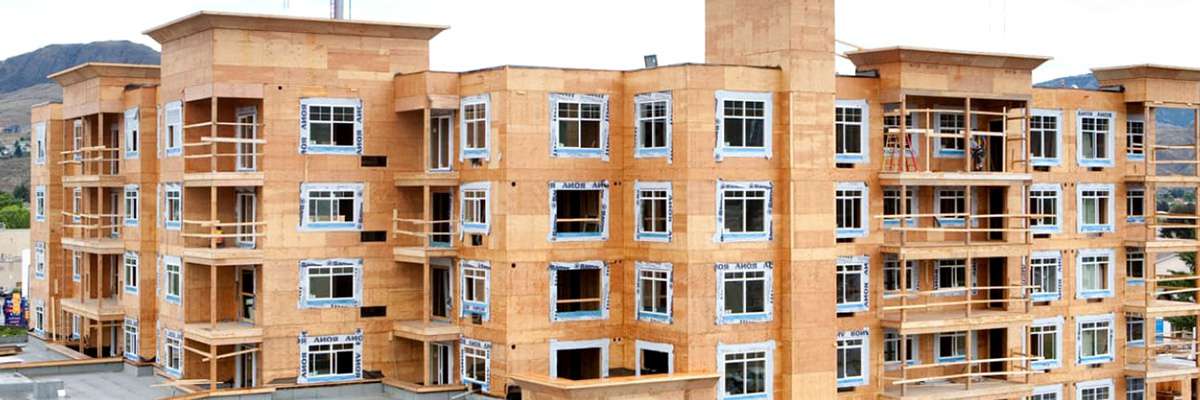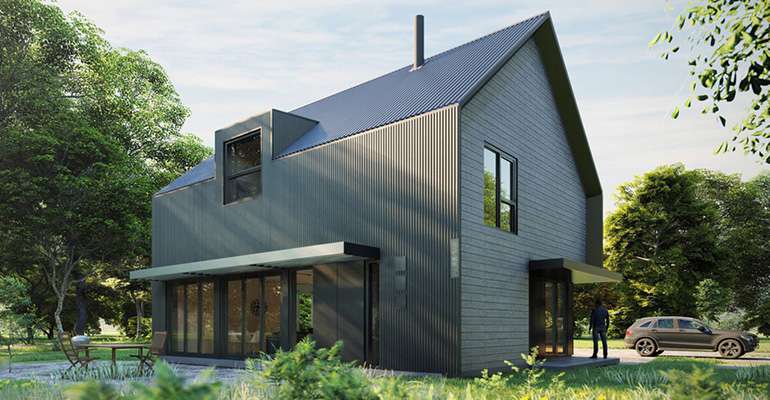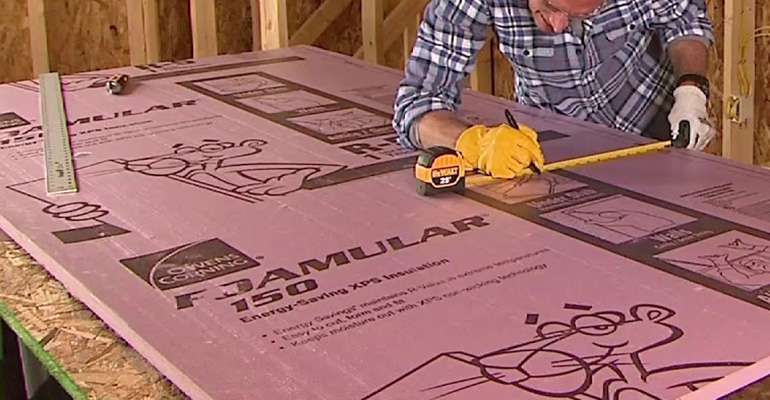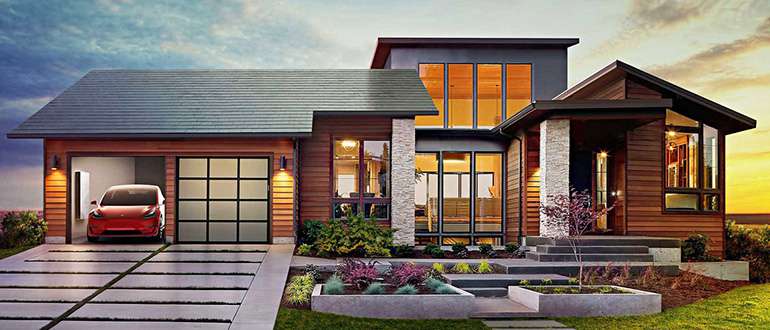
(The Top Twelve Green Building Trends for 2020)
FIND OUT WHAT’S TRENDING IN 2020 FOR GREEN HOME CONSTRUCTION
Top Sustainable Construction Trends for 2020
There are always new green building products coming out that lead to more efficient, more durable or more eco-friendly homes. But most of what grabbed our attention this past year, and the things that we will see through 2020, are perhaps best described as sustainable construction design philosophies, tools, and even education. So below is a list of green building trends for 2020 and product improvements that we are pretty excited about. These either arrived in 2019, made serious ground in 2019 or are expected to be released in 2020. So here are our faves!
1. Prefabricated kit homes LEED or ZNE ready
Prefab houses are by no means new, but we have seen a few promising looking players show up in the Architect designed prefabricated kit house market, and Google search results indicate this is a quickly growing search term.
Prefab kit houses built in the controlled environment of a manufacturing facility and LEED, ZNE or Passive House ready are often able to achieve a higher standard of quality than site-built homes where the raw materials and shell of the house are often left exposed to the weather for extended periods of time.
Kit houses also avoid bad weather delays, labor overruns and damaged materials from lying in the rain. Indoor shop manufacturing also lends itself better to material reuse and recycling, as smaller pieces of wood and Insulation can be sorted, stored and later reused.

(Prefab Passive House & LEED Kit Homes for Sale in Ontario & North Eastern US States on EcoHome)
Look for more and more prefab home manufacturers to hit the market every year, with better quality and competitive pricing. That’s of course just our prediction, (although a leading industry report published subsequently back up that prefab and modular construction is a hot new trend for 2020 – see The Prefabrication and Modular Construction 2020 SmartMarket Report by Dodge Data & Analytics here) but we believe that the idea of having the ‘parts’ of a home delivered to a site and assembling a house in place will, in the future, sounds an silly as having a bunch of car parts delivered to your house and having to assemble it yourself in your laneway.
The big advances in prefab homes that you can expect to see coming soon, at least for the manufacturers that we believe will take a lead in the market, is an ability to produce and deliver a finished and affordable prefabricated modern Home that is LEED, Zero Net Energy or Passive House ready in as little as 8 to 10 weeks. If you are looking to buy a high performance prefab home and aren’t an Ecohome Member yet, sign up here for hot sustainable construction news and offers in the coming months.
2. ZNE – Zero Net Energy homes
The higher cost of energy combined with an increasing awareness of the global climate crisis is a driving force behind the trend towards more energy-efficient home construction. And Zero Net Energy home construction is a trend that is quickly taking off; read more here about the Canadian Zero Net Energy Pilot program results.
But for the short story, if you didn’t already know or haven’t yet guessed, a Net Zero house is one that produces as much energy as it consumes. It starts with an energy-efficient building envelope that includes high-efficiency heating and ventilation components systems to help keep the consumption of the home as low as possible, and it is then powered by renewable energy sources like roof-top solar panels. Watch for more ZNE or Net Zero ready houses to start popping up.
3. BIM & Carbon footprint calculator for materials
One of the most exciting building tools we’ve found lately is the EC3 carbon footprint calculator. Programs like the ZNE mentioned above can really benefit from this, since, to determine the entire carbon footprint of a building from cradle to grave, you would need to know more than the amount of energy that will be consumed during operation; you need to know the embodied energy – which is the energy required to manufacture the building materials in the first place.
The EC3 tool from Skanska is a free-to-use tool that has a data base of materials that allows architects and designers to calculate the embedded energy of a building design, which means materials can be swapped in the design phase to keep the footprint as low as possible. Until now this has been a complicated process that was not undertaken very often; without knowing that variable, there was no way to accurately assess the total ecological impact of a building.
Using this tool builds on the adoption of BIM or building information modeling, which is another associated construction industry trend that will carry over into 2020. BIM is a way of representing buildings, roads, and utilities through computer-generated images to help contractors visualize a construction process before it is built. Architects and engineers can use the models to visualize how building materials will hold up over time.
If a subcontractor can visualize their part of the project before beginning work, and they have access to accurate data like that the EC3 tool provides, they can accurately estimate how much of a specific material is needed and the carbon impact of different similar materials to make the best environmental choice. This visualization capability also reduces the amount of wasted time, labor, and materials on a project.
4. Spray foam and XPS foam with lower emission blowing agents
Styrofoam board insulation and spray foam insulation have always had a bad rap in the green home construction industry, and not without good reason, but the true problem is not what most people think. A brief pause here while I slip on the Kevlar vest I wear when I defend foam insulation in the green building community…
The actual environmental damage from foam products is less about the fact that foam insulations are petroleum-based products (because they are actually mostly captured air), and more about the gases (blowing agents) that are used to fabricate them. Oil extraction isn’t good, no argument there. But digging anything out of the ground to ‘make stuff’ isn’t great for the planet, neither is cutting trees or growing crops to make insulation.
To label something an ‘eco-friendly building material’ can only be done if you calculate its full impact, (See the EC3 calculator above) and the fact that a relatively small amount of raw material is required to fabricate foam insulation is a definite advantage.

(Owens Corning XPS rigid insulation boards)
Since the most concerning environmental problems with foam insulation comes from the gases that are used to expand the foam beads into dimensional form (some gases are more than 1400 times worse than carbon as a green house gas contributor), that’s where solving the problem starts too.
The biggest culprits for releasing harmful green house gases are spray-polyurethane foam (SPUF) and XPS rigid insulation, but there is good news on both of those fronts. There are currently 2 spray-foam manufacturers that have switched to the lower impact HFO blowing agents (hydrofluoroolefins rather than HFC Hydrofluorocarbons), and we have reason to believe 2020 will see the arrival of XPS rigid insulation boards with lower GHGs as well (Green House Gas emissions). Read more here on our page about choosing the best rigid insulation panels.
I know it’s a hard one to wrap your head around, but XPS foam panels are poised to become 1400 times LESS polluting, so when that happens it will become a viable option for sustainable and ecologically responsible home building.
Ecohome readers will be the first to know when the new panels hit the market, so sign up (for free) and we will let you know the moment they are available.
5. Statutory building performance disclosure requirements
Towards the end of 2019, several cities implemented regulations requiring mandatory disclosure of the energy-efficiency of homes before resale. This is a huge leap forward in providing homeowners with the information needed to make sensible home purchases, and to know the extent of renovations that would be needed to improve the energy efficiency of a home.
This is already mandatory in numerous European countries like France – allowing homebuyers to make better choices in the homes they are thinking of buying and driving up the adoption of energy efficient home renovation industry as better homes attract a premium price.
Interesting to note also that in Europe where this has been adopted, poorly performing homes have significantly dropped in value. Ecohome lives in hope of seeing the day when a homes’ Energy Efficiency Rating is more important than whether it has granite countertops or twin vanities in the master bedroom ensuite.
This is a great trend in the residential market to follow the 30+ US cities that as of about 2015 required all commercial building owners to disclose the energy efficiency performance to tenants and buyers.
It should come as little surprise that a discouraging amount of energy efficiency initiatives and climate crisis mitigation strategies fall short of their targets, so steps like this that make targets more achievable are always encouraging.
Specifically, in this case we are referring to the Architecture 2030 standard that was adopted in 2007, which targets a 50% reduction in energy consumption from 2005 levels, with the end goal being that all new buildings be Net Zero Carbon (ZNC) by 2030, which is defined as an energy-efficient building that produces or procures enough carbon-free energy to offset its consumption.
6. Water conservation measures
Awareness of the predicted crisis in fresh water supply in many regions of the world will increase as climate change continues to disrupt rainfall and water supply systems worldwide in 2020. The 2014–2015 drought in California, with more than 70% of the state in extreme drought by summer 2015, brought water concerns to national attention and has been compounded by the disasterous wildfires in 2019.
These wildfires in California were also mirrored in recent years by disasterous summers for fires in BC Canada, Montana, and most recently by those in Australia at the end of 2019 and beginning of 2020. 2019 has gone on record as the second hottest year on record – which is a poor omen for the future of sustainable water resources.
Heightened concern about the impact of future restrictions on water supplies and cost is prompting many building designers, owners, and managers to consider ways to further reduce water consumption in commercial and residential buildings, such as adopting some of the following water conservation strategies:
- Using more water-conserving fixtures and low-flow toilets
- Installing low-flow showerheads
- Water-permeable surfaces and stormwater management strategies
- Rainwater catchment systems
- Graywater recovery systems
- Installing green roofs
- Planting native and adapted vegetation in place of lawns or ornamentals
Investing in the above, and other things such as efficient cooling towers, and other innovative approaches to reducing on-site water use is something already being done in Germany, Australia, and many other European countries.
Improved water conservation and wastewater treatment regulations are something that has significantly changed in recent years in Europe and new green building rating and certification programs like LEED V4 and PHIUS+ have started to take water efficiencies into account. Expect this to further develop in 2020 in the US and Canada, with stand-alone and consumer friendly greywater treatment products like Hydraloop gray water treatment system coming to the market having won a CES Innovation Award in 2020.
7. Virtual/ Augmented Reality in construction
Virtual Reality, also called Augmented Reality has been around for a few years now, but the construction industry found a plethora of new applications for it in 2019 like safety training that are sure to continue to be developed in 2020.
Virtual reality allows users to experience complex logistics first-hand to get a more accurate gauge of the project or product. It helps provide a digital visualization of our real world with added data to augment the experience and allows for a 360-degree view of the project.
It also offers some interesting possibilities for “on-site” training or product support without the necessity to be on-site – saving transport costs for time/money and carbon footprint and a virtual “hands-on” experience for learning about new sustainable building products and installation techniques.
We at Ecohome are hoping this speeds the adoption of better sustainable construction products and methods, and makes training quicker and easier to encourage more people into the construction trades and ease some of the chronic shortages of trained construction tradespeople in 2020 and beyond.
8. Increase in PV Solar panels on homes
There has been a steady increase in the installation of solar panels on homes in North America, which is encouraged by technological advances, decreasing prices, as well as recieving help from states in the form of Renewable Portfolio Standards (RPS).
By the end of 2015, 37 US states had requirements for a percentage of energy production to be renewable. The most aggressive of those is California, which set a target that 33% of energy production had to be renewable by the year 2020, and a 2019 report from the California Energy Commission says they are on track to meet that.
It also shouldn’t be a surprise to find Tesla as a big part of the increase in residential solar panel installations, and Tesla solar roof financing starting in 2019 makes generating renewable energy more affordable, and in some cases even profitable.

(Tesla solar roof tiles are now in V3 and are set for 1000 installs a week by the end of 2020)
9. Non-toxic building materials and healthy homes.
Building healthy homes with safer indoor air quality is a trend that increases in popularity every year, and we think 2020 will offer significant growth. New non-toxic building products hit market regularly, but what is important is when box stores opt for more eco-friendly material options. This is a reflection of the trend towards protecting indoor air quality in homes, as well as being a trend setter, since people are more likely to choose them if they are easier to find.
Ecohome comprehensively supports the work of “Mind the Store” who have had many victories in getting poisonous chemicals out of the US’s major retailers – including the notable victory of getting Home Depot to banish Phthalates from Vinyl Flooring in 2015-6. Check out your local materials retailer for their hazardous chemicals policy here
Another example we heard of but are still trying to confirm, is that Ikea may actually be offering healthier cabinetry materials than we think, that are formaldehyde-free. If it turns out to be true (as it is in Europe) then their 50+ stores across North America may already be offering formaldehyde-free kitchens and bathrooms, but they just aren’t tooting their horn about it. It’s time to toot! Keep an eye out here for an update on that – or contact IKEA North America here to ask for more info and let us know what you discover.
When building products go from being a fringe market to being displayed in mainstream box stores is when they really get noticed, which also helps drive prices down and encourages competitors to follow suit.
The more builders and home owners ask suppliers for more sustainable and non-toxic building products, the more they will supply them.
10. Coach houses, laneway houses and urban infill building
Urban infill construction slows urban sprawl and protects green space. That’s a good thing. But as so often is the case, those living in established older neighborhoods are often loath to see changes to their communities and increases in traffic, which is a fully understandable sentiment. But it doesn’t change the fact that the lowest-impact living occurs when new homes make use of existing infrastructure such as roads, sewers, power lines and public transportation.
Many cities have passed legislation allowing pilot programs for back yard coach houses, or laneway houses (Vancouver, Canada being an excellent example). In a landmark appeal case in December 2019 Ontario BCC has clarified building-code making the rules easier to get a permit for legal laneway homes & Tiny Houses in Toronto from May 2020.
Another common sight is to see an older, smaller and possibly rundown house being removed, and a duplex being built in its place. We get it; it sucks when it happens next door to you but on the grand scheme of things, every residence built inside a city’s limits means one less house was built outside of them.
11. More options for Green building certifications
Passive House certified homes consume about 90% less energy that a code-built house. As a green home certification program, Passive House is getting a boost from some regional building codes in the form of financial incentives that helps legitimize it in the eyes of both homeowners and builders alike. Some municipalities are also implementing tougher regulations that are ‘inspired’ by programs like LEED or Passive house, and requiring air-tightness targets to be met. This is not a small thing, since too few builders realize how much heat loss is due to air leaks in a home, and how important an air-tight home is for durability and efficiency. Also, we’re seeing a proliferation of Net Zero Energy and Net Zero Ready certification schemes being devised making it easier for home buyers across the US and Canada to recognise and choose greener homes – and with choice and competition these should progressively become more affordable, accelerating the number of new home builders and owners who demand better homes – Ecohome hopes that these Net Zero certification schemes will establish common grounds for qualification all the same.
12. Mass Timber Panels
Cross Laminated Timber (CLT) and Mass Timber Panels are more frequently replacing metal and solid wood as structural beams in buildings and homes, or so it would seem in the circles where we travel. This is a great trend towards preserving natural resources and old growth trees, as Mass Timber Panels are made from post-industrial waste wood as well as smaller dimension trees from logging that are normally too small for any commercial use.

(Cross laminated timber interior)
We can assume the increase in use of CLTs for framing can be attributed in part to an awareness of environmental issues and an upswing in the demand for green homes, but don’t forget the power of architectural trends and running with the cool kids. Open concept buildings with natural light and exposed structures have been a consistent theme for many years, and such trends seem to hold better when there is a ‘noble’ cause as well, and preserving forests makes everyone feel good. More demand for green building products brings more suppliers and gives manufacturers better access to the products with more competitive pricing, so here’s hoping that eco-friendly home construction stays cool!
